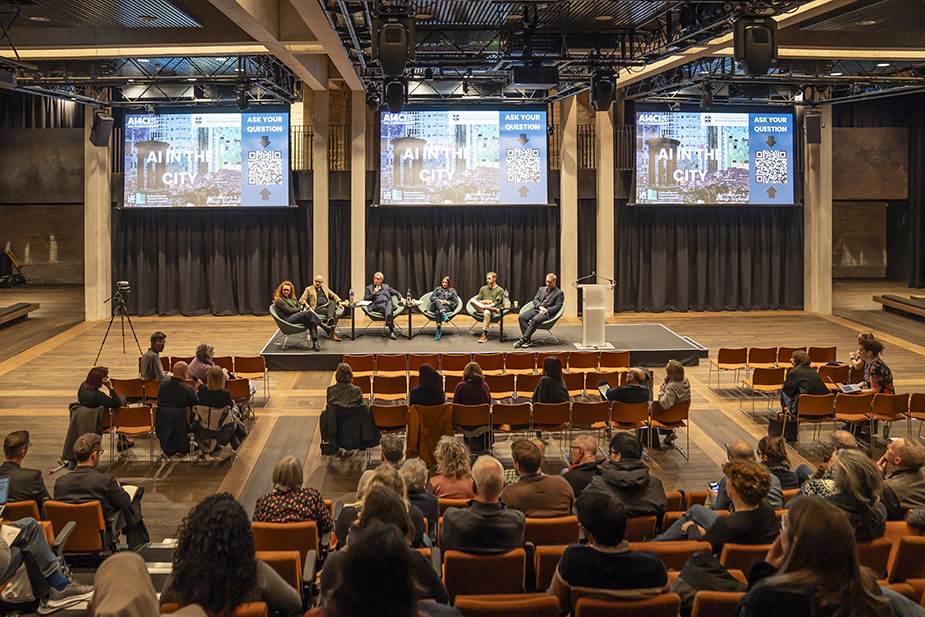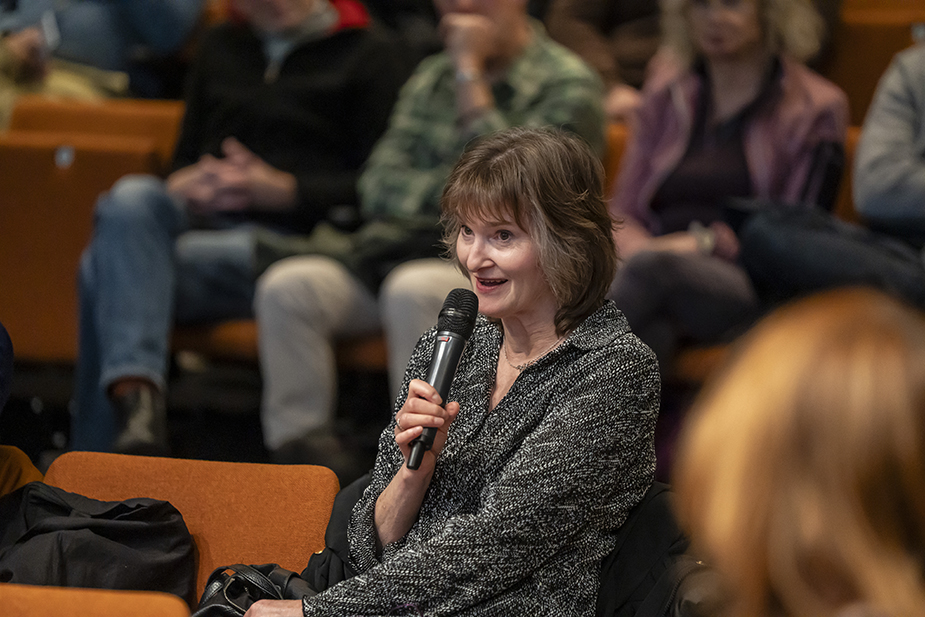AI in the City: exploring the future of urban life

On 30 October 2025, the Edinburgh Futures Institute (EFI) became a hub for forward-thinking discussion as experts, policymakers, architects and community members gathered for AI in the City, a two-part event exploring how artificial intelligence is shaping urban environments and community engagement.
Satellite Event: AI in the City Public Forum workshop
The afternoon began with a Satellite Event hosted by Architecture and Design Scotland and the AI for Collective Intelligence Hub (AI4CI). Ian Gilzean, Head of Digital Place and Innovation at Architecture and Design Scotland, opened the session, followed by Professor Seth Bullock, who introduced AI4CI and its mission to foster collaborative approaches to AI in city ecosystems.
Two dynamic panels showcased cutting-edge research and practical applications:
AI and community engagement
The first panel of speakers, focused on AI and community engagement, included Dr Alex Taylor from the University of Edinburgh, Dr Susan Lechelt from the University of Edinburgh, and Ellie Burroughs from Imagine If. Space CIC.
Speakers addressed the role of digital tools in improving community engagement and considered how AI infrastructure might shape the future of our cities.
AI in the Street
Dr Alex Taylor’s presentation explored the public’s views of AI and how it can manifest itself (often unseen) into the fabric of the built environment. He presented findings of an engagement process with residents of Leith Walk in Edinburgh, which used a variety of participatory methods, including “data walks”, prompt cards and a street-based design intervention.
These methods aimed to build a picture of local concerns and how they relate to the increasing influence of AI in daily life. For example, the extractive qualities of AI were seen as a potential contributor to unwelcome changes to the neighbourhood (e.g. loss of local identity, transport or choice in supermarkets), and highly generic data was now thought to be informing decision-making about the built environment. You can read about Dr Alex Taylor’s project here: Leith Walk, Edinburgh Observatory
Value-centred design for communities
Dr Susan Lechelt’s presentation highlighted her work supporting diverse audiences in engaging with emerging technologies (physical computing, AI, the Internet of Things, etc.) in new ways through playful, novel approaches. Her research seeks to understand future directions in data-driven innovation for the creative industries, and she presented examples of the work of two of her PhD candidates.
Saoirse Houtmeyers is exploring how the use of AI might support or challenge creative values at different stages of the filmmaking process, from background research and ideation through to project management. These processes could also teach less experienced film-makers about creative workflows or simplify complex and specialised tasks. A similar AI workflow analysis could be used for different processes, such as architecture. Sarah Immel’s research considers how visual metaphors could help creatives reflect on their values and feelings about future technology, e.g. what metaphors beyond “assistant” or “editor” can be useful for future AI creative writing tools?
Immersive tools and resources for community engagement
Ellie Burroughs from ‘Imagine If’ demonstrated how creative uses of data collection and data analytics can enhance community engagement techniques, whilst avoiding consultation fatigue. These included using history to talk about the future, and a game that aimed to challenge people to think differently about the design and layout of future housing.
As part of a ‘CoStar’ Residency, she has recently been exploring Augmented Reality and Virtual Production technologies to support innovative approaches to community engagement and how ideas are shared through new visualisation methods.
AI for transport and connectivity
The second panel of speakers, focused on AI for transport and connectivity, included Dr Yahya Gamal from the University of Glasgow, Ewan Doyle from Scottish Borders Council, and Tom Sharples from the Scottish Government Digital Directorate.
Using data for mobility modelling tools
Dr Yahya Gamal provided an impressive overview of a highly interactive mobility tool which could systematically analyse journey times, choices and routes. It could test the impact that interventions such as road closures would have on journey times, and the choices on rerouting or modal transfer that travellers may take.
The final element of the tool was a mobility modeller, which incorporated National Travel Survey data to provide a robust baseline for the analytical functions of the modeller.
Analysing data to support workforce mobility in the Scottish Borders
Ewan Doyle presented a data case study focused on the Workforce Mobility Project for the Edinburgh and South East Scotland City Region. This is supporting behaviour change, whilst reducing transport barriers to employment, training and further education across the City Region.
Ewan highlighted their Postcode Analysis Tool (PAT), which allows businesses to receive updates on their workforce's travel options. When used in conjunction with the Sustainable Transport Assessment Tool (STAT), the analysis can identify growth opportunities for infrastructure and services. He presented a number of examples of the benefits of combining the data. This included an impressive 200% rise in passenger numbers on new bus routes based on projected user demand for services, which also then released efficiency savings for reinvestment.
Using and sharing public data to tackle the housing emergency
Tom Sharples presented a case study which used publicly available datasets to build up a picture of new housing development in smaller towns across Scotland. This is based on a need to better understand how things are changing at a local level and to interrogate data on housing in a clear visual way.
By using property-level data from Energy Performance Certificates (EPCs) – including construction date, property type, location and size (floorspace) – information can be consistently integrated with other datasets, such as existing homes, schools, supermarkets, GP practices, settlement boundaries and population information.
Tom demonstrated three examples of how the data could be formatted in a combined map and dashboard, which told the story of housing growth in relation to an existing town and the inter-relationship with other facilities and services such as healthcare and education. This provides a communal but consistently detailed resource for wider use and application.
Evening Public Forum: AI in the City
Later that evening, EFI hosted the AI in the City Public Forum, a free event moderated by Scottish broadcaster Stephen Jardine. The panel featured leading voices from government, academia, and industry:
- Alison Heppenstall, University of Glasgow & AI4CI
- Tom Wilkinson, Chief Data Officer, Scottish Government
- Caroline Parkinson, Edinburgh Futures Institute
- Jeremy Doherty, Arup
- Raffaele Esposito, Glasgow City Council
The discussion explored how AI is influencing city living, planning, and governance – addressing opportunities, risks, and the impact on communities.

Opportunities and risks of AI
Edinburgh is one of the UK’s leading cities for AI and Edinburgh University has been a pioneer in AI since the 1960s.
AI is already in use in design practice, as highlighted at the event by the Queensferry Crossing project, where the team applied AI to optimise the design solution and used sensors to monitor ice build-up on the structure.
In Glasgow, an environmental digital twin is helping city planners and urban designers to understand and develop solutions linked to a number of ‘smart city’ initiatives such as traffic management, lighting and a 3D city model.
AI can be a positive tool in city design, given the complex nature of the challenges faced, such as climate change, the housing emergency and transport. Using AI effectively can enable us to collaborate, improve systems, and even anticipate problems before they happen. AI could also be used to increase citizen engagement in the planning and development process
In the creative industries, the growth in AI was creating new opportunities and business models, but also creating ethical and intellectual property challenges and other dilemmas and risks.
The ‘black box’ nature of AI was discussed, and the problems of not knowing the basis or potential bias in the data used in Large Language Models (LLMs).
Could locally based AI options be developed in a distributed model that supported local communities? Could a distributed network of data centres be linked to energy networks to recycle heat and mitigate environmental impact? The panel agreed that the human dimension is always needed in the application of AI. We need to ensure that we prevent digital technologies and AI from replicating and amplifying existing inequalities and discrimination in our cities.
In summary, AI is an incredibly powerful tool that should be there to serve humanity by making the best use of data and evidence, but society needs to remain in control of its use and impact.

Questions that sparked the debate
Audience members didn’t just listen, they steered the conversation. They challenged speakers with questions about how cities can balance the rise of AI with human priorities.
Top concerns included how businesses can be incentivised to hire graduates instead of relying on AI solutions, and whether AI’s promise of smarter, more liveable cities outweighs its heavy environmental footprint. People also pushed for inclusive data practices that capture the voices of diverse communities.
Other thought-provoking questions touched on what happens if the AI bubble bursts, whether public awareness is keeping pace with rapid adoption, and if Scotland’s education system is ready for the digital future. And beyond efficiency, participants asked: do we risk forgetting the joy of places when everything is optimised?

Jim MacDonald, Chief Executive of Architecture and Design Scotland, said:
“AI is set to transform the way our cities are shaped. However, while we all recognise the huge potential of AI, what is less clear is how and on whose behalf it will be deployed. Will it empower citizens to influence the decisions that affect them? Will it drive increased inclusion and decision-making that reflects the diversity of our communities?
As Scotland’s champion for architecture and the built environment, we believe that these and many other questions demand exploration. AI in the City was a chance to do just this and to invite the public to join the debate alongside academics, practitioners, and policy makers.
The event was part of our wider work exploring the role digital innovation can play in design and placemaking. This now forms a significant part of our work and we look forward to many more conversations, debates and discussions on this topic in the coming years.”
Professor Seth Bullock, Director of AI for Collective Intelligence, said:
"It was fantastic to hear such a balanced and informed discussion of the ways in which AI is set to impact on our towns and cities - and to see the huge degree of interest that people have in the important issues that have to be faced if this impact is going to be positive for the people that live in them."
Dr Kristy Doherty, Director of Public Services, Sector Engagement Lead and Co-Director of the Scottish Prevention Hub at the Edinburgh Futures Institute, said:
"Architecture and Design Scotland is a key partner in the Public Services Ward at EFI, and AI in the City demonstrated exactly why these collaborations matter. The event showed the power of bringing designers, academics, public service leaders and communities together to explore how AI can shape more inclusive, resilient and future-focused places.
At EFI, our mission is to convene people and ideas to tackle complex challenges, and this partnership exemplifies that-combining creativity, data-driven insight and system-wide thinking to support better outcomes for Scotland’s communities."

All images taken at the AI in the City Public Forum are credited to Aly Wight.
